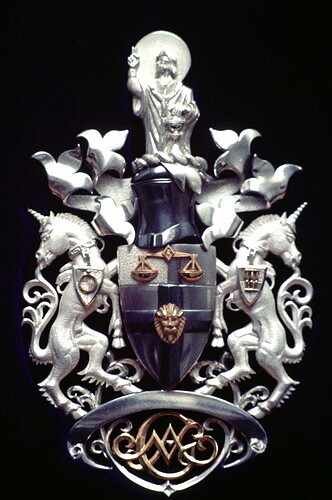For a beginner it is absolutely no! Technique must acquired with
traditional gravers. After that, it is a personal choice.
There are other exceptions too, Leonid. I have one of the Lindsay
airgravers, and I love it. I didn’t used to need one, but these days,
I do. After 42 years with type one diabetes, I’ve got some problems
with neuropathy in my hands, and no longer have quite the strength or
control I used to have. the Airgraver lets me still do the same work
without having to stress out. And some of the engraving work I do is
more in the nature of carving, needing pretty deep cuts to model a
design pattern in fairly hard white golds. With just the hand tools,
I’d have to do these cuts with many successive shallower cuts. With
the airgraver, I can hog out a lot more metal than my poor old hands
ever could. Perhaps this doesn’t really qualify as fine engraving,
since it’s more brute force metal cutting. But it gets the job done.
Such tools are also useful for anyone who may know how to engrave,
but who simply doesn’t need to do it very often. Engraving really
well requires more than just knowing how to sharpen and control
tools. It also requires a certain muscle tone, and sufficiently
frequent practice to retain control, or you end up having to spend
the first half one one of those occasional jobs with your hand
relearning it’s technique. People who do it regularly, won’t need
this. But I recall one engraver I knew some 35 years ago who felt
keeping in practice sufficiently important for him, that when he went
on vacation, He’d take an engraving ball and tools and practice
plates with him, just to keep in hand muscles toned up. That may be
dedication beyond what everyone will do or needs, but the quality of
his work attested to his results. Now, perhaps you are sufficiently
skilled and practiced that you don’t find the above scenario to be
true for you. That’s great if so. But for some of us, just as some
older folks find a walking stick to be of use, the power gravers are
useful for more reasons that merely being production tools.
As with any tool, a change in the tool may result in less skill,
until someone is used to it. So you may be right that someone who’s
skilled in hand engraving would find less fine control with a power
tool. But I’d suggest that with practice, that fine control is
regained. A simple look at the type of work Steve Lindsay does with
his tools should be sufficient evidence that the tools do not lessen
the potential for top quality work in any way.
And while you are quite correct in the idea that for a beginner,
using a power graver will mean the beginner never learns to actually
control a hand graver. That’s true, of course. In simiular manner,
someone who owns a rolling mill and drawplates will never learn how
to hammer a chunk of metal into uniform sheet metal, and then cut and
shape wire from it. For my money, I’m not sure I mind having missed
those last skills. I’m just as happy knowing it’s how it was done,
and not being able to do it because I’ve got the faster tools now.
Likewise, if I were wishing to learn how to engrave, and could afford
a good power tool knowing it would cut down on the time it took me
before I could produce acceptable results, I’m not sure this would be
a bad thing. Yes, it limits the student to needing that power tool to
do the work. So less skill is learned. The control over the hand
powered tool isn’t learned if it isn’t required for the power tool.
Certainly this is not good for tradition. But I’m not sure it’s so
bad for the craftsman who may be more interested in getting to the
point where he or she can produce the desired results.
It’s somewhat traditional for experienced craftspeople to be prone
to looking down at the newer generation who’ve somehow bypassed the
skills we had to learn. “Kids these days” is a refrain in professions
in addition to just parenting. We had to learn it the old way, so
damn it, they should need to, and if they don’t, then they’re not
learning the right way, or learning as much. Shameful. Right? That’s
the way the argument seems to go in many cases. But how much of this
is real, and how much of it is simply resistance on the part of an
older generation to change and improvements that we didn’t have?
And I can’t say I know the answer to that for certain. On the one
hand, I feel it’s valuable for students and learning craftspeople to
learn as much about the heritage, history, and previous methods as
possible, even if they don’t need to do everything the hard way any
more. The education enriches and deepens the understanding of the
craft. And it gives a greater appreciation of the craft, both the
older methods and the new, for people now doing things the “new”
way. But at the same time, sometimes spending lots of time learning
the traditional methods when there have been improvements in
technology or available tools and materials, simply means that people
spend time reinventing the wheel and learning to drive a horse drawn
carriage rather than learning how to drive with the latest
automobiles. For some, learning about horses and carriages will be
useful, enlightening, and enriching. For others, they may simply want
to drive to work…
Peter Rowe
